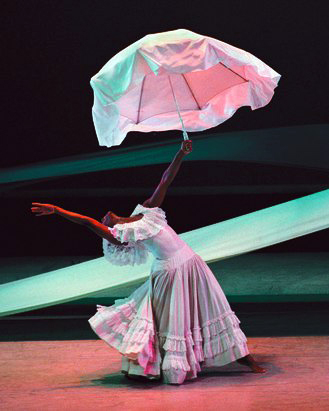Backwards and Forwards
Alvin Ailey American Dance Theater
Opera House
The John F. Kennedy Center for the Performing Arts
Washington, DC
February 7, 2006
by Kate Mattingly
copyright ©2006 by Kate Mattingly
 Few dancers today are masters of the broad strokes of movement and the delicate details. The beauty of the Ailey company is that its dancers excel at both and their repertory showcases this range. The audience erupts in applause when the dancers unveil their superhuman extensions and god-like leaps, but it’s the more subtle movement quality that allows the same artists to illuminate a work like Hans van Manen’s “Solo.”
Few dancers today are masters of the broad strokes of movement and the delicate details. The beauty of the Ailey company is that its dancers excel at both and their repertory showcases this range. The audience erupts in applause when the dancers unveil their superhuman extensions and god-like leaps, but it’s the more subtle movement quality that allows the same artists to illuminate a work like Hans van Manen’s “Solo.”
In an opening night program that spanned 45 years of choreography, it was easy to see why this company has achieved such mass appeal and tremendous success. In addition to their new Alvin Ailey American Dance Theater (AADT) headquarters in Manhattan and a 24-city tour this season, the company just announced that the Ailey Archives are being donated to the Library of Congress and digitized.
Artistic Director Judith Jamison has a lot to be proud of and her curtain warmer on Tuesday night expressed this confidence. She has culled a world-class group of artists: watching Alicia J. Graf, a former principal with Dance Theatre of Harlem, sharing her exuberance and exquisite lines with the company is a testament to AADT’s ability to draw the cream of the crop. Other standouts include Hope Boykin, who was a powerhouse with Philadanco prior to joining AADT, and is still the type of dancer who makes it hard to watch anyone else on stage.
Clifton Brown, in both “Solo” and Jamison’s “Reminiscin’,” combines strength and tenderness in a way that’s breathtaking. As the first man on stage in “Solo,” he floats through multiple turns, then accents the music by Bach with a shoulder shrug that is idiosyncratic and perfectly placed. A similar lushness is evident in his performance of Jamison’s “Reminiscin’.” Dancing with Boykin in a duet set to Joni Mitchell’s song, “A Case of You” (performed by Diana Krall), they exchange lifts and caresses that leave no doubts about their sincerity. Boykin’s attention to detai—the way she guides her hand up his armi—endows the choreography with a human sensitivity.
This gem of a duet is almost lost in the ensemble scenes that surround it: “Reminiscin’” consists of seven vignettes set to music sung by Sarah Vaughan, Ella Fitzgerald, Roberta Flack and others. It tends to drag after the fourth scene, in spite of an all-star cast of 11 (Matthew Rushing, as always, is phenomenal). If Jamison’s piece needed editing, at least there was material there worth working with, unlike the evening’s opener by David Parsons.
This has been asked beforei—here in DanceViewTimes a couple years agoi—but why are there so few choreographers who can highlight AADT’s incredible talents? Except for Ron Brown, the artists who are commissioned seem to expect the performers to transform choreography that’s bland and cliché. “Shining Star” is a prime example. In addition to relying on the performers to make something of ordinary, unison movement, Parsons rides the music by “Earth, Wind & Fire.” It’s great music and takes a listener back to a particular place in time, unlike the choreography. The steps by the dancers are the same quirky bent-legged skips we’ve seen Parsons’ dancers do, and the contorting lifts for the womeni—their legs wrapped around the men’s necksi—end up looking generic and contrived. The costuming by Ann Hould-Ward keeps some interest: the women look sexy baring their writhing midriffs and the men are incredibly sleek when they come out in long white trench coats. Even though the dancers do their best throughouti—especially Graf who whips her legs into gorgeous shapesi—the best part comes as the lights dim and the curtain lowers: the cast is grooving in their own individual ways, and they look fresh, engaging and exciting.
“Revelations,” ultimately, provides a sense of catharsis: stunning choreography that transcends the decades and gives the dancers space to express both the superhuman and the subtle moments. Glenn Allen Sims brings new poignancy to “Fix Me, Jesus.” Partnering Linda Celeste Sims, he seems to draw her up by an imaginary string as he beats the air above her head with his hand.
To close with such a landmark piece on the same day the country observed the funeral of Coretta Scott King made for a singular occasion. “Revelations” had its premiere four years prior to Martin Luther King’s “I Have A Dream” speech, and, like King’s words, it is an inspiring testament to and hope for free expression and equality.Volume 4, No. 6
February 13, 2006
copyright
©2006 Kate Mattingly
www.danceviewtimes.com
|
|